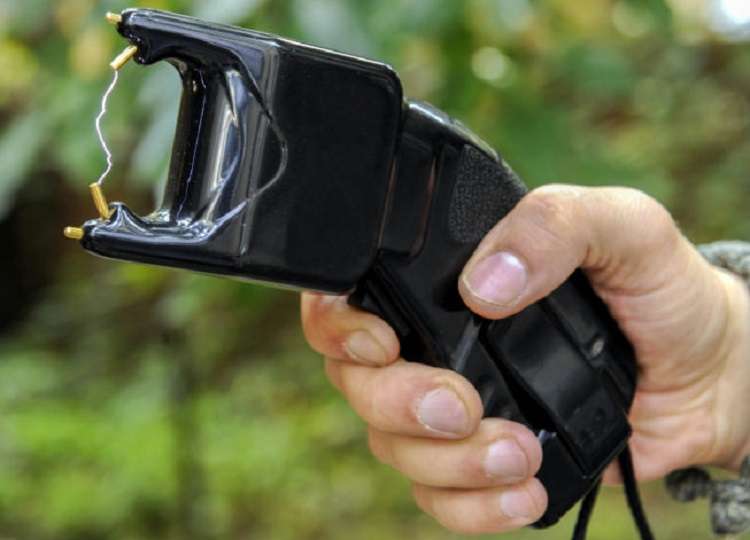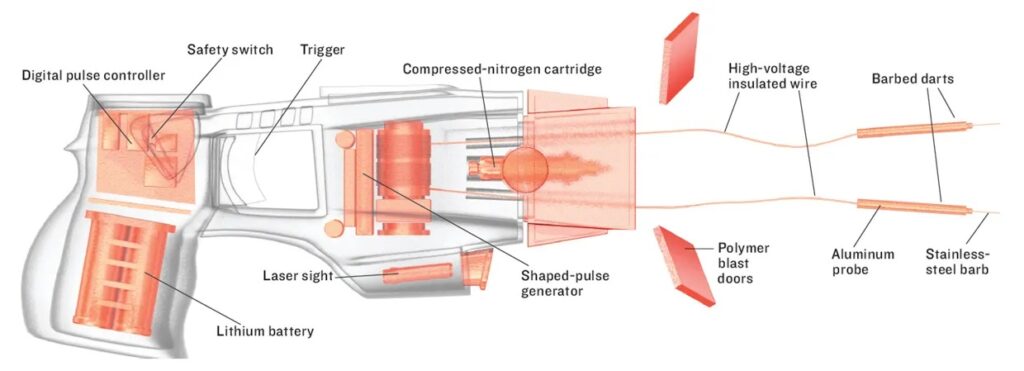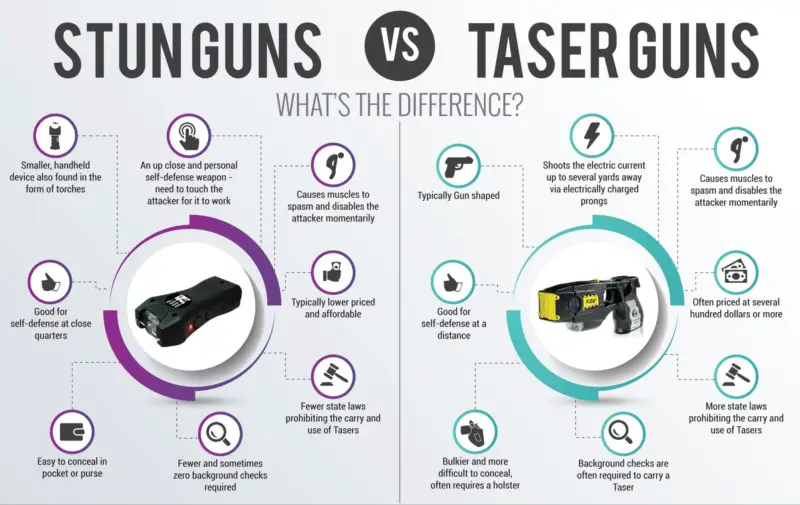Table of Contents
When it comes to personal defense, understanding your equipment is not just essential; it’s a matter of personal safety and empowerment.
Over the years, stun guns and tasers have become popular tools in the self-defense arsenal. They offer protection, yet surprisingly, many individuals remain unclear about their distinct functions, features, and capabilities.
By knowing the difference between these two devices, you can make a more informed decision tailored to your specific needs and comfort level.
In this guide, I’ll dissect the differences between stun guns and tasers, shedding light on their mechanisms, advantages, and limitations, to guide you in choosing the right tool for you.
What is a Stun Gun?
Stun Gun Overview

A stun gun, at its core, is an electrical self-defense device designed to incapacitate an aggressor without causing severe harm or long-term injuries.
Unlike what the name might suggest, it doesn’t shoot anything; instead, it requires direct contact with the assailant to deliver its electric shock.
In other words, you have to get really close!
How a Stun Gun Works
When activated and pressed against an individual, the stun gun releases a high-voltage, low-amperage electrical charge. This current travels into the muscles, causing a rapid energy loss.
Imagine your muscles working at super speed without control; it’s akin to running a marathon in mere seconds. This extreme activity of the muscles depletes the body’s energy reserves, leading to temporary immobilization and disorientation.
The individual will likely be dazed and unable to move, giving you precious moments to escape. What’s important to understand here is that while the voltage is high, the amperage is low, which means it causes pain and disruption without long-term harm.
Pros and Cons of a Stun Gun
Pros:
- Compact Design: Stun guns are designed for convenience. They can fit easily into a purse or pocket, making them easily accessible when needed.
- Cost-effective: Generally, they’re less expensive than other self-defense tools like tasers, making them a popular choice for those on a budget.
- Immediate Impact: Upon contact, the stun gun incapacitates almost instantly, providing immediate protection.
Cons:
- Close Proximity Required: You need to be close to your assailant to make contact, which can be risky.
- Multiple Shocks Needed: Depending on the situation or the aggressor’s tolerance, you might need to administer multiple shocks.
- Legal Restrictions: In some regions or states, carrying or using a stun gun is restricted or requires permits.
Stun Gun Usage Tips
When using a stun gun, aim for large muscle groups like the chest or thighs for maximum effect. Always be aware of your surroundings, and after using the stun gun, move to a safe location immediately. Regularly check the battery to ensure it’s charged and ready for use when needed.
What is a Taser Gun
Taser Gun Overview
Tasers, often mistaken for stun guns, have become a staple in both law enforcement arsenals and civilian self-defense tools. Unlike stun guns, tasers have the capability to incapacitate a target from a distance.
The name “Taser” is an acronym for “Thomas A. Swift’s Electric Rifle,” inspired by a science fiction novel. Today, it stands as a testament to the blend of fiction and reality in our evolving self-defense technologies.
How a Taser Gun Works

When activated, a taser shoots out two small dart-like electrodes connected to the main device by thin conductive wires.
Once these darts make contact with the target, they penetrate clothing and deliver a series of electrical pulses that interfere with the brain’s communication to muscles. This neuromuscular incapacitation results in an almost immediate loss of the individual’s ability to control their movements, causing them to fall or freeze in place.
The effects last for several seconds to minutes, depending on the model and settings used, allowing ample time for an individual to escape a threat.
Pros and Cons of a Taser
Pros:
- Range: The most significant advantage of a taser is its range. You can incapacitate an aggressor from several feet away.
- Immediate Incapacitation: Its mechanism ensures that targets are rapidly immobilized.
- Safety Mechanisms: Many modern tasers come with added features like laser aiming, LED lights, and even built-in cameras for evidence capture.
Cons:
- Price: Generally more expensive than stun guns due to their technological features.
- Cartridge Replacement: After a single shot, the cartridge needs to be replaced.
- Legal Concerns: Like stun guns, tasers face legal restrictions in several jurisdictions, often even stricter.
Usage Tips
Always familiarize yourself with your taser’s features. Training courses can help with accuracy and safe handling. When aiming, target the center mass, like the back or chest, for optimal effectiveness. Keep extra cartridges on hand, and remember: the taser’s primary goal is to give you time to escape danger.
Stun Gun vs Taser – the Difference

Both stun guns and tasers are powerful tools with unique features tailored for specific situations.
Understanding these differences can help you choose the most suitable device for your needs. Here’s a detailed comparison:
Range
Winner: Tasers
One of the starkest differences between the two is the range. Stun guns require you to be in immediate proximity to the potential threat, demanding you to touch the aggressor directly. This can be daunting and risky, especially in volatile situations.
Tasers, on the other hand, provide an upper hand with their ranged capability. They can effectively immobilize a target from a distance, typically around 15-30 feet, depending on the model.
Reusability
Winner: Stun guns
Stun guns are champions of reusability. Once charged, they can deliver multiple shocks in rapid succession without the need for any replacements.
Tasers, conversely, rely on cartridges that deploy the dart-like electrodes. After one shot, the cartridge needs replacing. If you miss your target or face multiple threats, this could pose a limitation unless you have extra cartridges at the ready.
Intensity of Pain
Winner: Tasers
Both devices are undeniably painful, designed to incapacitate rather than cause long-term harm. Stun guns cause intense pain at the contact point, which can make assailants recoil and retreat.
Tasers deliver a more distributed shock, disrupting the neuromuscular system and causing involuntary muscle contractions throughout the body. The sensation from a taser is often described as more intense and incapacitating.
Size
Winner: Stun guns
Stun guns, given their simpler design, are generally more compact. This allows them to be concealed easily in pockets or purses. Tasers, with their cartridge mechanism and often additional features, are bulkier, more closely resembling small firearms in shape and size.
Ease of Use
Winner: Stun guns
Stun guns are straightforward in their operation: get close, press, and deliver the shock. Tasers require a bit more finesse. You need to aim accurately, consider the distance, and be aware of the surroundings (like bystanders). Training can significantly enhance the effective use of a taser.
Price
Winner: Stun guns
When it comes to cost, stun guns usually have the edge. Their simpler design and construction often make them more affordable for the average consumer. Tasers, embedded with more advanced technology and requiring cartridges, typically come with a heftier price tag.
Additionally, ongoing expenses, like cartridge replacements, can make tasers a more costly long-term investment.
Stun Gun vs Taser – Which is Better?
Making a choice between a stun gun and a taser is like picking between an umbrella and a raincoat on a stormy day. Both will keep you dry, but your preference depends on the specifics of your situation. Let me share my thoughts based on my experience and research.
Situation and Context
From a personal safety standpoint, the distance advantage of a taser is undeniable. I’ve always felt that having the ability to immobilize a potential threat from several feet away provides an added layer of security. There’s a peace of mind in knowing that I don’t need to be within arm’s reach of an assailant to defend myself.
Comfort and Training
I’ve found that the stun gun’s simplicity offers comfort to beginners. No aiming, no cartridges, just a direct approach.
However, the close proximity requirement can be unsettling. With a taser, there’s a learning curve. I’ve invested time in training sessions to ensure I can aim accurately and understand the device’s nuances. For those willing to put in this effort, a taser can be a game-changer.
Budget Considerations
On a tighter budget, I’d naturally lean towards a stun gun. They’re generally more affordable upfront. However, if I’m considering a long-term investment and am okay with occasional cartridge replacements, a taser would be my choice, despite the initial higher cost.
My Verdict
Ultimately, the “better” choice is deeply personal. It’s about understanding your needs, gauging your comfort levels, and assessing the situations you might encounter.
For me, both devices have their moments. Some days I prefer the convenience of the stun gun, while on others, the security the taser offers from a distance feels more reassuring. Whichever you choose, prioritize safety, regular training, and stay updated on legal considerations.
Wrapping it up
Understanding the difference between a stun gun and a taser ensures you’re equipped for personal safety. Consider factors like range, price, and ease of use.
Stay informed, train regularly, and prioritize your safety. Remember, it’s not just about owning a tool, but knowing how to use it effectively.
